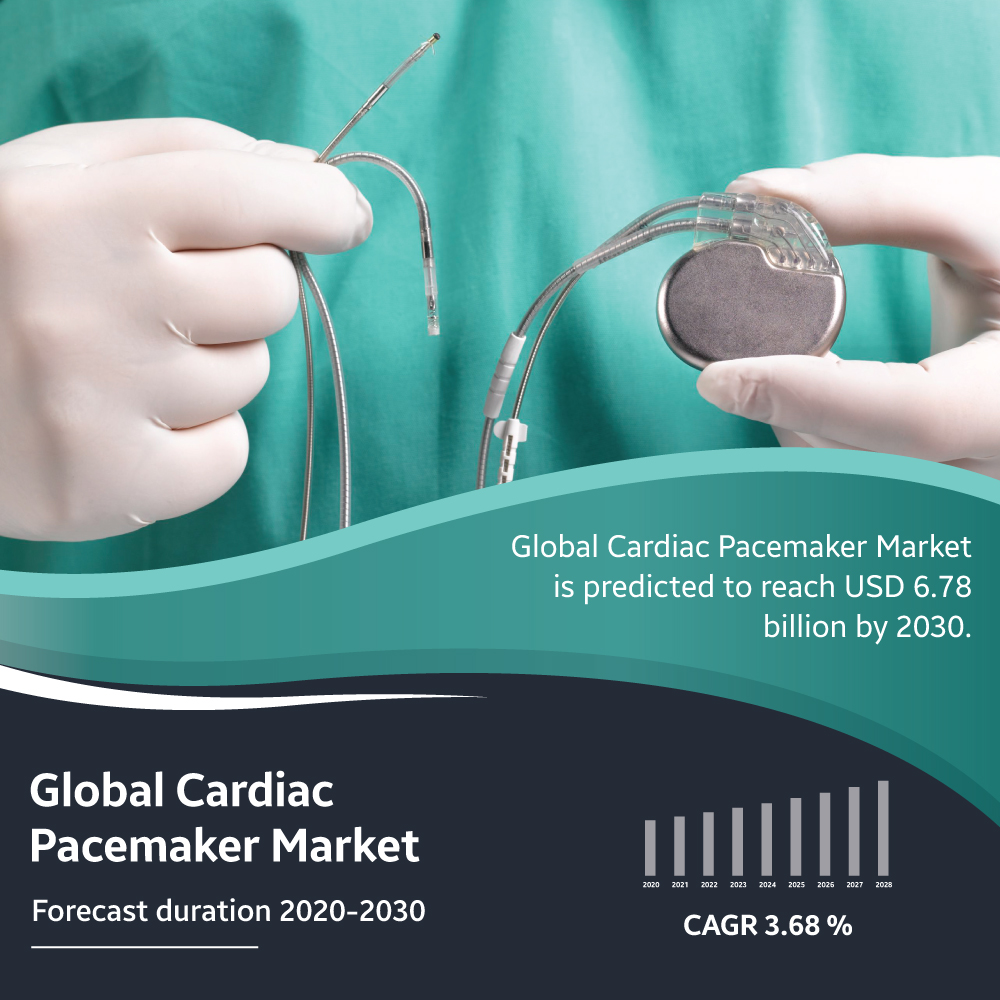The market for Cardiac pacemakers will grow at a healthy CAGR of 3.68%, from a value of $3.93 billion in 2021 to $7.21 billion by 2030.
An artificial cardiac pacemaker, often known as a pacemaker, is a medical device that produces electrical impulses and delivers them via electrodes to the heart’s upper or lower ventricles in order to force the targeted chambers to expand and pump blood. The placement of a pacemaker inside the chest necessitates surgery. Another name for a pacemaker is a cardiac pacing device. The most frequent cause of pacemaker implantation is bradycardia, which is when the heart is beating too slowly or pauses, leading to symptoms like fainting spells. In some circumstances, the pacemaker could also be used to stop or cure an irregular or too-rapid heartbeat (tachycardia).
Market Dynamics
DRIVERS:
- One key factor driving the economic expansion of the cardiac pacemaker market is the steadily increasing occurrences of CVDs (cardiovascular diseases). The American Heart Association (AHA) reports that 868,662 people died in 2017 because of CVDs. Coronary heart disease (CHD) was the main reason of death in the U.S. in 2018, accounting for 42.1% of all fatalities, followed by stroke (17.0%), high blood pressure (11.0%), Heart failure (9.6%), vascular disorders (2.9%), and other CVDs (17.4%).
- Governments all over the globe have raised their spending on Cardiovascular Disease Management (such as cardiac resynchronization, cardiac surgeries, etc.) as a result of the rise in CVDs, which is significantly boosting the growth of the global market. In the United States, there are over 500,000 open-heart procedures performed each year, including coronary artery bypass surgery and a number of more intricate aortic procedures, as per Lifespan Health System. Additionally, according to a recent SMR study, there are more than 900,000 cardiac procedures conducted annually in the U.S.
RESTRAINTS:
This market’s total growth is being severely constrained by the rise in bradycardia, pacemaker infections, blood clots, air leakage, & Twiddler’s Syndrome, among other issues.
OPPORTUNITIES
The production of premium pacemakers (biventricular pacemakers), which completely satisfy all of the patient’s needs and provide individualized treatment, is currently the sole focus of international organizations. These recent developments are significantly increasing workflow accuracy and enabling error reduction rates, which is providing a tonne of future market prospects.
Market Segmentation
Product Outlook
- Dual Chamber
- Implantable Cardiac Pacemakers
- Biventricular Chamber
- Single Chamber
- External pacemakers
Type
- MRI Compatible Pacemakers
- Conventional Pacemakers
Applications
- Congestive Cardiac Failure
- Arrhythmias
- Atrial Fibrillation
- Heart Blockage
- Long QT Syndrome
- Others
End-User
- ASCs (Ambulatory Surgical Centers)
- Hospitals & Cardiac Centers
- Others
Geography
North America
- USA
- Mexico
- Canada
- Rest of N.A.
Europe
- Suomi (Finland)
- Hungary
- Germany
- U.K.
- France
- Switzerland
- Turkey
- Netherlands
- Rest of Europe
Asia Pacific
- Japan
- China
- South Korea
- India
- Australia
- Rest of APAC
LAMEA
- Argentina
- Brazil
- Saudi Arabia
- Uruguay
- Rest of L.A.M.E.A.
According to Product Outlook, the “Implantable Cardiac Pacemakers” market will dominate in 2020 with a market share of over 63.75%. The main reasons propelling this market’s expansion include the rise in the use of these devices to treat heart failure, arrhythmias, and arrhythmias, as well as ongoing clinical trial procedures.
According to Type, “Conventional Pacemakers” held the biggest market share, accounting for around 52.37% of the total market. Small size, high affordability, and ongoing technological advancements are the main elements promoting category growth.
The fastest growing segment, on the other hand, was “MRI Compatible Pacemakers” over the course of the anticipated period. The Mayo Center for Medical Research and Education estimates that in 2018, 78.36 percent of patients with implantation pacemakers required an MRI at some point in their lives. As a result, the segment’s growth rate was the greatest.
With a market share of almost 39.21 percent in 2020, the “Arrhythmias” segment led the market in terms of Applications. The risk of cardiac arrhythmia is rising as a result of factors like excessive alcohol use, obesity, smoking, as well as other lifestyle diseases, which is, in turn fueling this market’s overall expansion.
The ‘Hospitals & Cardiac Centres’ considerably dominated the market in terms of end-user during the estimated period, accounting for a total revenue share of about 62.37%. The factors spearheading the growth of this market are the increase in cardiac patient admissions and the great reimbursement facilities during procedures. By 2030, there will likely be an additional 23.6 million cardiac patients, according to the American Heart Association.
Depending on the region, North America notably held the greatest market share for cardiac pacemakers during the anticipated time period, at close to 43.78%. Throughout the anticipated period, a strong CAGR is anticipated in the U.S. pacemaker market. The market in this area is expanding as a result of an ongoing rise in the number of elderly people with cardiac issues, quickening technology development (such as Bluetooth-enabled artificial hearts, MRI-friendly pacemakers, etc.), & enhanced regulatory approvals.
Key Companies
- Medtronic
- Boston Scientific Corporation
- MicroPort Scientific Corporation
- Zoll Medical Corporation
- BIOTRONIK
- Cook Medical
- Pacetronix
- MEDICO SpA
- Osypka Medical GmbH
- Oscor Inc.
- LivaNova
- Lepu Medical
